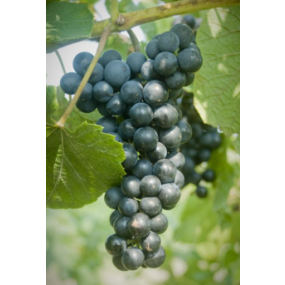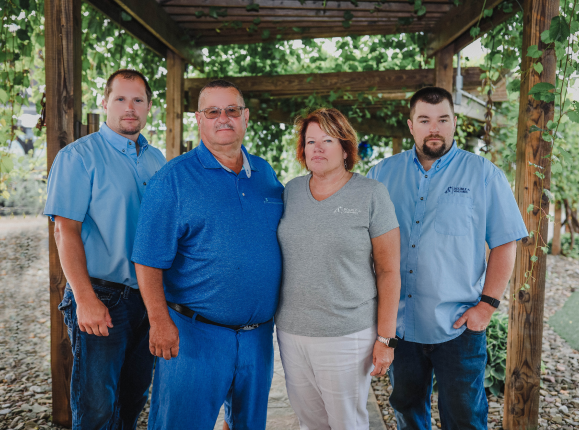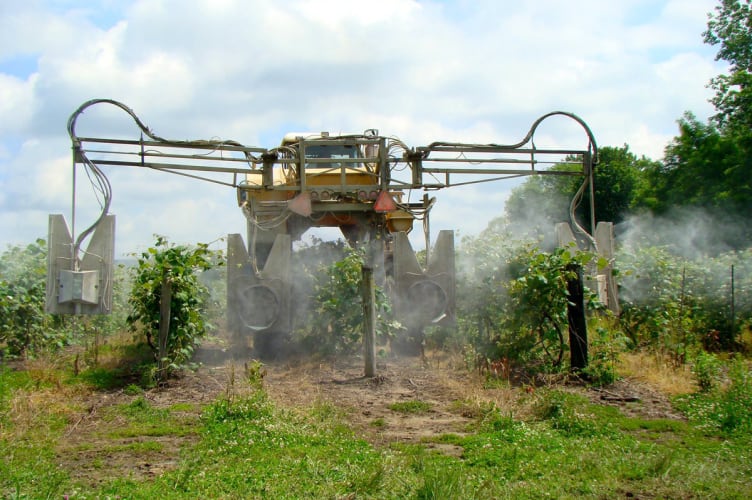Establishing a New Vineyard

Rick Dunst, Viticulturist, Double A Vineyards, Inc.
Spring has sprung (albeit 3-4 weeks early in Western New York) and Double A Vineyards has begun shipping vines to our customers in warmer climates. This month’s article will cover the basics of pre-plant land preparation, how to handle vines once you receive them, methods of planting, and early care of the vineyard.
Pre-plant Land Preparation
Pre-plant decisions such as choosing an appropriate variety for your site have been covered in a previous article at: https://doubleavineyards.com/news/choosing-the-right-grape-variety-for-your-location/. Other tasks that should be completed prior to planting include:
1) Soil testing. Take a soil test to determine the need for supplemental fertilizer applications prior to planting. Soil test kits can be obtained from many University Extension offices or from private labs. Information about soil sampling can be found at: https://doubleavineyards.com/news/vineyard-fertilizer-and-nutrient-recommendations-provided-by-double-a-vineyards/. Regardless of where your soil is analyzed, I would be happy to assist you in determining the nutritional needs of your vineyard (which is somewhat dependent on variety). Many nutrient levels can be adjusted after planting, but lime applications, if needed, are best made and incorporated into the soil prior to planting.
2) Weed control. Weed growth is highly competitive with grapevine establishment, and weed control is the most important factor in vineyard site preparation. Perennial weeds need to be controlled prior to planting the vineyard. The systemic herbicide glyphosate will control most actively growing perennial weed species, and does not have residual effects in the soil that might interfere with early grapevine growth. On erodible sites, plowing can be delayed until the spring, or a cover crop can be planted in the fall to provide protection over the winter. If a cover crop such as rye is planted in the fall, it can be killed with a glyphosate application in the spring, or it can be plowed under.
Vine Delivery and Pre-plant Handling
When you order vines from our nursery, we will assign a shipping date. If that date is not suitable due to weather conditions or other reasons, please contact our office at least two weeks prior to the assigned shipping date so we can make adjustments.
Your vines will arrive in a cardboard box or bag with a plastic lining, with moist shredded paper around the roots. Open the package and inspect the roots to ensure they are moist. If needed, sprinkle a little water around the roots to moisten them, but do not add so much water that the roots are saturated. If planting will be delayed for a few days, re-seal the box and store in a cool location, but do not let the plants freeze. Vines can be stored in this manner for a week or more, as long as the plants are kept cool and moist. On the day of planting, roots can be soaked in water so they are fully hydrated at planting.
Planting methods
There are many methods to plant grapevines, depending mainly on the size of the vineyard to be planted. A shovel works fine for a few vines or more (for someone with a stronger back than me). A tractor-mounted auger can be used to drill several hundred holes per day by an experienced operator. If planting into an augered hole, it is important that the roots are well distributed in the hole, if necessary they can be trimmed to fit in the planting hole.
Larger plantings are usually made with a tree/vine transplanter that digs a trench and covers the roots with soil. This process will require two or three people: a tractor driver and one or two on the transplanter. Details on this technique can be found in Vineyard Establishment II – Planting and Early Care of Vineyards. For very large plantings, custom laser planting may be warranted.
Planting and Pruning
Make sure you know if you are planting an own-rooted or grafted vine. Own-rooted vines are tagged with a designation such as 1-1 (one year grade one vine) or 1-X (one year extra large vine). Grafted vines are tagged with a designation such as Riesling/101-14 or Seyval/3309; in other words, the variety name followed by the rootstock type.
1) Planting own-rooted vines. Make sure the hole or trench is big enough to spread the roots out. If planting in a trench or with a transplanter, there is no need to prune the root system, simply spread the roots out in the trench in both directions, if possible, before backfilling with soil. If using an auger, it may be necessary to trim the roots to avoid bunching them up in the hole. The soil line from the year the vine spent in the nursery should be visible, and the vines can be planted to a similar depth. Essentially, about half the vine goes in the hole, and half remains exposed. Vines can be pruned before or after planting as described in the “Dormant Grape Planting Questions & Answers” pamphlet included with your shipment.
2) Planting grafted vines. Planting depth is more critical for grafted than own-rooted vines. It is important that the graft union be planted 2-3” ABOVE the final soil line. Vines planted too deeply will produce scion roots (from the variety, rather than the rootstock), which defeats the purpose of planting on a rootstock. If vines are planted too shallowly, with the graft unions several inches above the soil line, it will be difficult to mound up sufficient soil for winter protection. Remember that in cold climates, graft unions must be protected with insulation every winter (and removed every spring) to ensure vine survival at extreme cold temperatures if no snow cover is present. For additional information on winter protection of grafted vines, refer to https://doubleavineyards.com/news/winter-protection-of-grapevines/. Grafted vines are shipped pre-pruned, additional pruning is not necessary unless some roots need to be trimmed so they are spread out in the planting hole.
Post-plant Care of the Vineyard
Several tasks should be completed following vineyard planting to ensure success:
1) Water in the vines if rainfall does not occur for several days after planting. Dormant vines do not require much water, but it is important that roots be kept moist so they do not desiccate. If soil is moist at planting, tamp the soil around the base of the vines to minimize the chance of the soil and roots drying out.
2) Hill up soil around the vines. Soil should be leveled after planting, leaving a slight mound. If vines were planted in a trench or with a transplanter and soil moisture is adequate, this process can be delayed for up to a few weeks, and soil can be used to cover the first flush of weed growth.
3) Maintain good weed control around the vines. Minimizing weed competition around young vines is critical. An extensive discussion on weed control options for newly planted vineyards can be found at:
http://lergp.org/year-planting/weed-management .
4) Use grow tubes. The benefit of using plastic grow tubes during the establishment year of a vineyard is the subject of debate. Some research indicates that the top growth of a few shoots is favored over root development. However, if animal damage or the use of a systemic herbicide such as glyphosate is anticipated, then the use of grow tubes supported by a bamboo stake is highly recommended. However, foliar feeding insect pests such as Japanese Beetle can defoliate vines within a grow tube, so the vines should be monitored on a regular basis and insects should be controlled as necessary.
5) Crop control. Any fruit that develops on first year vines should be removed to encourage vine growth and development of a healthy root system.
6) Fertilization. If soil nutrition has been adequately addressed prior to planting, no additional fertilizer is generally required, although some growers apply 4-6 oz. of a balanced fertilizer like 16-16-16 (or equivalent) sprinkled in a band around each vine. (See Maxsea 16-16-16 sold by Double A)
7) Pest control. Some pest control will likely be needed during the establishment year of the vineyard. Consult local University guidelines. I will be addressing vineyard pest management issues in a series of articles as the growing season progresses.
For additional information on methods of planting and field marking, and care of newly established vineyards, consult the Michigan State publication Vineyard Establishment II – Planting and Early Care of Vineyards, by Thomas J. Zabadal, available on our website.















What is the maximum recommended row length for Geneva double curtain trellis using wolverine cross arms?